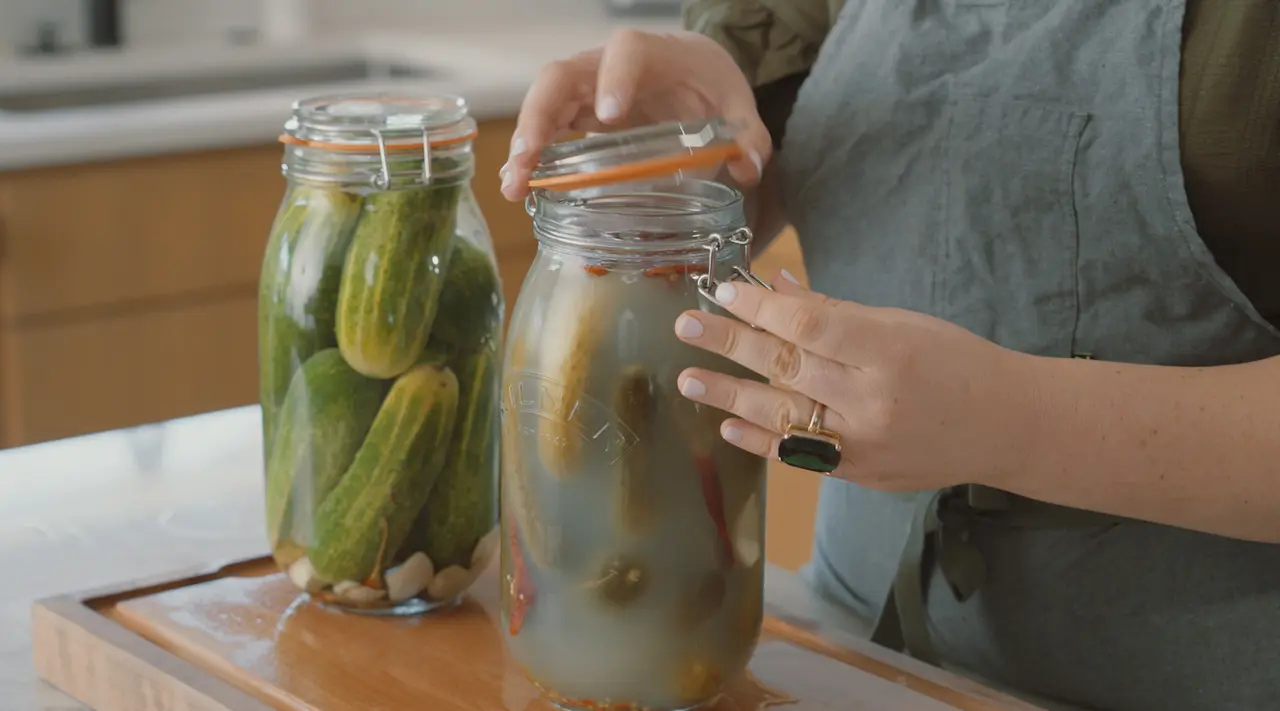Phoebe Raileanu of Casper Fermentables in Austin, TX knows her way around a fermented vegetable. Her partner Ben Hollander started the company six years ago and she joined him (“in both love and business,” she adds) about three years in. They are inspired by their shared Jewish ethnicity and his Korean heritage to make fermented vegetables, kombucha, and baked goods. So who better to talk about the differences between quick pickling and lacto-fermentation?
What You Need to Ferment
Before you begin, it’s extremely important that you sterilize your jars. You can do this by boiling them in water for 10-15 minutes. Below are the rest of the tools you need to help your pickling process, where it’s quick or lacto-fermented, go smoothly.
A Reliable KnifeThe first thing you need to get started is a good knife. “I would use the 8-Inch Chef Knife,” says Raileanu. “I like to have one trusty knife that can do anything I need in a kitchen, and you’re going to want something that has a bit more oomph, since you're cutting through fresh vegetables, which can be rigid. The most important thing is that it needs to be really, really sharp.”
An Easy-to-Pour SaucepanIf you’re making quick pickles, you’ll also need a vessel for heating up your pickling liquid. Raileanu recommends a Stainless Clad Saucepan, because it is easier to pour the liquid out. “When it comes to pouring and knife skills, it's all about speed and confidence,” she says.
A Storage ContainerYou will also need something to keep your pickles in. There are a wide variety of Mason jars available on the market, so you can take your pick of shape and size. You can use fermentation if you like, but Raileanu opts to pack her pickles extra tightly in their jars so they stay put.
What Are Quick Pickles?
Quick pickles are also known as refrigerator pickles because they are not canned or fully shelf-stable—so you have to keep them in the fridge. Making a quick pickle is simple: all you need to do is create a hot mixture of vinegar and water, and pour that over your vegetables. They only require a few days (or hours if you’re really in a hurry) in their brine before they’re ready to use.
“Quick pickling is a way to preserve vegetables without the slow process of fermentation. It allows you to incorporate ingredients like sugar and fresh or dry spices into your brine,” Ralineau says. “They’re great for when you need something fast and you want it to taste good right away. If you think of something pickled and your first thought is vinegary and/or sweet, that's a quick pickle.”
Quick pickles are a great option if you want that sweet, salty burst of flavor, but you want them now. You’re likely to find them in a bahn mi or other sandwiches, on top of sushi bowls or alongside bbq, and of course, in the form of pickled onions, atop a taco.
What Is Lacto-Fermentation?
Lacto-fermentation on the other hand is a lengthier undertaking with preservation in mind. Despite its recent spike in popularity, the process of fermenting food with salt has been around for centuries. You’re still using a brine like you did in quick pickling, but this time, instead of using vinegar or heating anything, you’re just combining salt, water, your vegetable of choice and letting it sit at room temperature.
As it sits in the jar, the vegetables themselves do the work. Beneficial microbes break down carbohydrates to produce lactic acid. This newly acidic environment helps to preserve the vegetables just like the vinegar does in the quick pickles. After a week or even a few months, you will have a preserved vegetable with a complex flavor, that is both probiotic and nutrient dense.
Lacto-fermentation is a great option for long-term preservation, as they can last for over twice as long than quick pickles, but the vegetables retain their crunch. “If you see something pickled and it has a cloudy brine, it's actively bubbling, or you eat it and the first flavor you notice isn’t vinegar, that's lacto-fermentation,” says Raileanu. Other commonly lacto-fermented condiments include yogurt, kimchi and sauerkraut.
Knife Skills and Pickling
When it comes to the knife skills required for quick pickling and lacto-fermenting, Raileanu’s biggest takeaway is be intentional. “You really need to think about your surface area, what's going to be exposed, and how quickly that will pickle,” she says. For that reason, try to keep cuts as even as possible to help ensure everything is pickling at the same rate.
Different shapes can be fun to play around with, like the delicate, caviar-eque pickled garnishes of fine dining or the playful, colorful pickles found in bento boxes, but in the end it comes down to timeline and aesthetics. “How do you want this to look on your plate? How quickly do you need this to be ready? How pretty do you want it to look in the jar? These are all questions to ask yourself,” says Raileanu.
Keep in mind that the smaller you cut the vegetable, the less time it’s going to take to pickle. Raileanu likes the 8-Inch Chef Knife because it gives her plenty of control, no matter what size or shape she decides to make her pickles.
Ready to Cook?
Now that you know the basics of quick pickling and lacto-fermentation, check out our video and recipe and follow along to make your own pickles. It’s a great way to use up extra vegetables, preserve the season, and incorporate bright flavors into a variety of dishes.






























